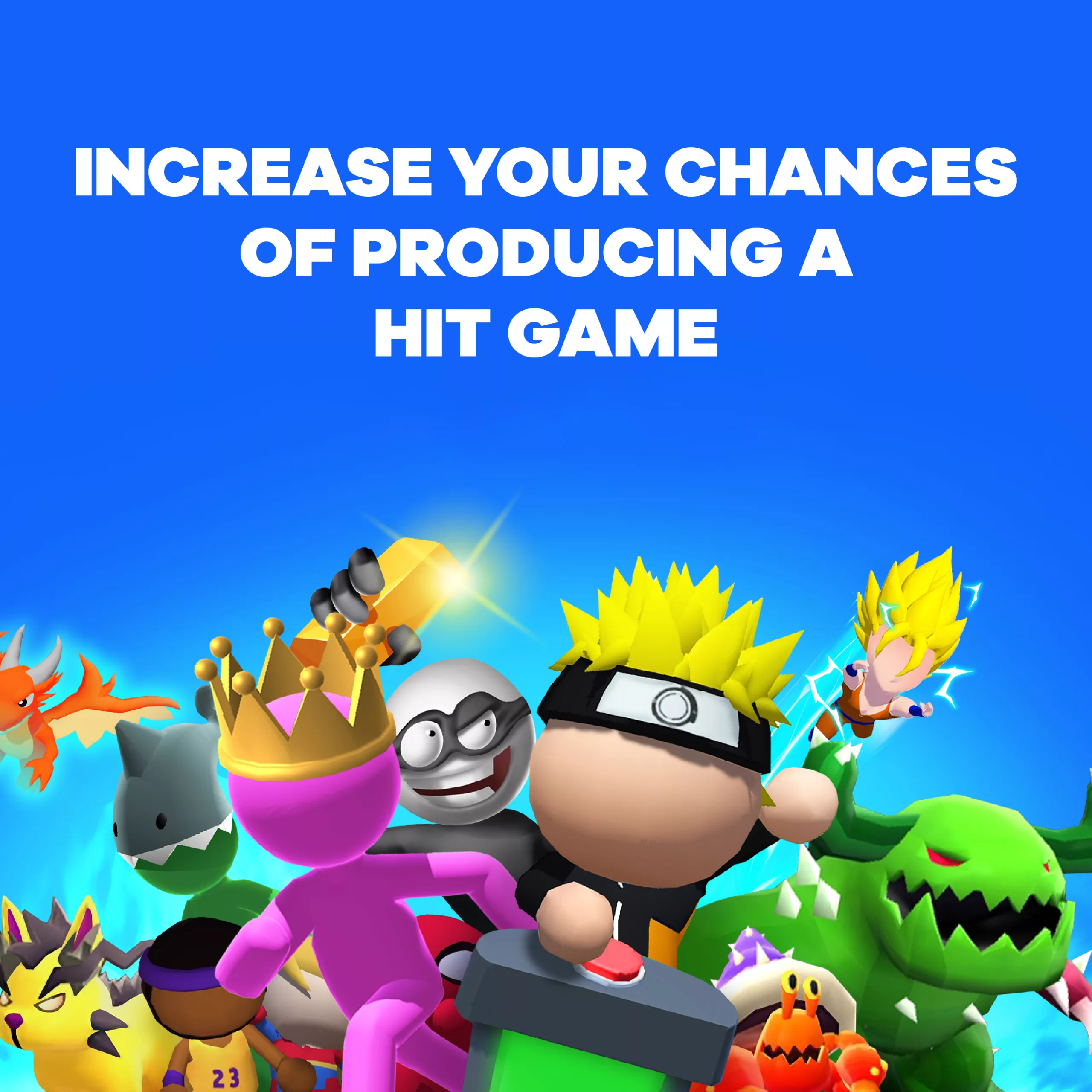
Rémy Di Mascio– Nov 26, 2021
One question that keeps coming up in the hypercasual universe is, “How to make a Hit Game?” Everyone dreams of achieving millions of downloads around the world. One thing’s for sure, however: there’s no magic recipe for creating a hit. This article won’t guarantee success and wealth, but it can certainly increase your chances of attaining a very promising CPI. We’ll tell you how, in just two years, TapNation generated 350 million downloads.
Identify a Promising Game Concept
Identifying a concept is no easy task. We all have preferences when it comes to games, gameplay, and even art direction. Most importantly, try not to design your game based on your own tastes. The goal is to make a Hit Game, which means targeting the masses. Each week, TapNation offers its partner studios 15 new game pitches using simple principles, which I will explain below.
Know your Competition
The principle is simple, you need to monitor the top charts daily for inspiration. The games that appear in the top 10 clearly have low CPIs, which is a good starting point. Next, you will need to identify market trends and try to understand what players liked about them, in order to start thinking in that direction. That said, you may also create a Hit by foreseeing the next big trend. Although, of course, that’s much harder to pull off.
Brainstorming

Once the market has been thoroughly analyzed, it’s time to brainstorm. This step is very important, because a well thought-out game is a well-produced game. It is best to brainstorm with people who know the hypercasual market. When you present your idea to them, the other participants may ask questions you hadn’t thought of. This will help tease out any weaknesses in your game pitch. Once the idea is clearly defined and approved by the brainstorming team, we recommend putting it all in writing, including all of the game’s details and specifics.
Create Game Prototypes

Hypercasual games are played a few minutes per day, over the course of many, short sessions. These games are played while waiting for public transport, so the player must be able to pause the game without interrupting the experience. To do this, create short levels that last one or two minutes.
The prototype must not exceed 10 production days. To that end, we recommend only producing about 10 levels. Since you don’t know if your game has potential yet, there is no point in producing the entire game.
We strongly recommend varying levels, for example, by changing the scenery, camera, or art direction. This will allow you to see the impact of these changes during the test phase. In fact, a simple change can divide your CPI in 2, so take advantage of this by varying a lot between levels.
Hypercasual games are designed for everybody to be able to play, and must be accessible to everyone. The more intuitive, clear, and simple your game is, the more people you can hope to attract.
The Creatives
Your prototype is finally ready, and you are satisfied with the progress you’ve made in 10 days of production. Now it’s time for the creatives! This is the most important part of the process, because the creatives you use will determine the number of clicks on your ads, and therefore the number of downloads. TapNation works with several internal teams to design successful creatives. Here are some tips:
First, stick to the formats that are accepted on platforms like Facebook and TikTok. The flagrant CPM increase on Facebook has led us to perform User Acquisition (UA) tests on TikTok. For each platform, we recommend testing between 4 to 6 videos per adset, following these specifications:
Facebook:
Facebook implements a number of very specific advertising placement options: 1:1 (1080×1080) – 4:5 (800×1000) – 2:3 (1000×1500) – 9:16 (1080 x 1920). It is important to follow these recommendations, because the ads can be placed in different parts of the platform: newsfeed, stories, Marketplace, integrated video, etc.
As for the length of the videos, they should not exceed 15 to 30 seconds.
TikTok:
There is only one format on TikTok, which is 9:16 (1080×1920). However, make sure to take TikTok’s UI into account. In fact, the bottom section as well as part of the right side of the screen are taken up by text and icons, which can obscure the game. This means it is important to account for these factors, and to focus the game’s action in a part of the screen that is visible in the application, as shown in the following layout. Short formats work better on TikTok. Videos should not exceed 10 to 20 seconds. Emphasize short, dynamic videos.
Now that you understand the specifics of each platform, it’s time to get creative. To help you out, we’ll share a few tried and tested tips. Keep in mind that you have less than 3 seconds to convince your viewers. And yes, 3 seconds is not much. The average ad viewing time varies between 3 to 10 seconds, depending on the quality of the ad. This means that lead-in should be effective, the gameplay must be easily understandable, and you should start with something dynamic. The first 3 seconds will determine whether the user will keep viewing your video, and especially if they will click on it.
Frustration is also a good way to get people to click on an ad. The person watching the ad must think to themselves, “I’m sure I can do better.” An ad that consists only of “fail” examples greatly increases viewing and engagement levels among web users (except in some particular cases). Don’t be scared to load silly situations, and to fail when the choice seems obvious, in order to frustrate the viewer as much as possible.
Now, let’s take a look at Art Direction. Bright colors are very effective in the hypercasual market. Don’t be afraid of using flashy, cartoony colors, and think in terms of pairs. One color dominates the scenery, while the other defines the goal or the gameplay. You should also play with brightness, level of detail, a crisp foreground, and more out-of-focus scenery in the background. Of course, this all depends on your game. But always keep the focus on the goal of the gameplay! Some games will use realistic art direction, while others will opt for more cartoony styles or a low poly approach. There is no set rule here, although some types of games tend to trend in particular directions. Car games tend to be more realistic, for example. But once again, there are no imperatives as long as the CPI works.
During the prototype phase, remember that it is advisable to vary the scenery, colors, and even the camera angle depending on the levels. In fact, these elements will come into play when you design your creatives and allow you to perform A/B tests. By testing the different types of scenery, cameras, or colors, you will obtain results that can halve your CPI.
Now you’re happy with your 4 to 6 creatives, you have various formats, colors, cameras, and even scenery available. It’s time to move on to the test phase. TapNation simultaneously tests games on TikTok and Facebook. We recommend a budget of $40 per day and per campaign, for 3 to 4 days. The learning phase takes around a day, so don’t be surprised if the results get better each day, that’s totally normal. At the end of the third day, if your results are very promising, you can choose to extend the campaign for another two days to see how far your CPI can decrease with a longer learning phase.
Interpreting the Results

The results will not be the same across all platforms and operating systems. Android has lower CPIs than IOS. For your initial tests, we recommend that you start testing with Android. Here are some facts that can help you interpret your results.
Facebook:
The recent releases of IOS 14 (and soon, IOS 15), combined with big CPM increases on Facebook have changed our way of interpreting CPI:
- CPI > $1: We think the project should be dropped
- $0.60 < CPIs < $1: We recommend re-working the product a bit, changing a few elements, and trying another quick test. If you manage to lower the CPI, keep working in that direction. Otherwise, drop the project.
- $0.40 < CPIs < $0.60: You are close to having a promising CPI. Finalize your product some more by adding details and more variety in scenery and colors, and you may be able to halve your CPI.
- 30 < CPI < 0.40: for certain products with a very high Lifetime Value (LTV), you can proceed to publishing a game with this sort of result. It is very rare, but it does happen in some cases. We recommend you keep implementing modifications until you can lower your CPI even further. Don’t be afraid to try a lot of different things, do cover all your bases for creative tests.
- $0.20 < CPIs < $0.30: You have a promising product. Use A/B testing to try to lower the CPI and change small details. If all the new tests return higher CPIs, restore the original version and focus on retention and good lifetime Value (LTV).
- $0.20 < CPI: If you obtain a CPI of less than 20 cents during your first Facebook test, there is a good chance your product will become a hit. Once again, the goal is to keep lowering the CPI by changing minor elements and re-testing as you go. Focus on good retention rates and lifetime Value (LTV), and you can be assured that your product will be profitable and can reach millions of downloads after a month or two of User Acquisition.
TikTok:
TikTok is still a new platform with regard to User Acquisition, and CPM is still very low. This means that for the same price as you spend on Facebook, your ad will reach nearly twice as many users. This also means CPIs are also lower than on Facebook. Here is how to interpret them for now:
- CPI > $0.70: We think the project should be dropped
- $0.40 < CPIs < $0.70: We recommend re-working the product a bit. Fixing a misunderstanding may be enough to divide the CPI by 2 or 3, with the possibility of creating a profitable product.
- $0.30 < CPI < $0.40: The game is close to having a good CPI, but it isn’t ready for publication yet except in very particular cases of very high lifetime Value (LTV) and strong retention rates.
- $0.20 < CPIs < $0.30: The CPI is starting to look promising. Implement modifications the colors, characters, scenery, or even the camera. The goal is to get under then $0.20 threshold.
- $0.10 < CPIs < $0.20: The product is ready to be published if the lifetime Value (LTV) and retention rates are also good. Once again, use several A/B tests to aim for an even lower CPI.
- $0.10 < CPI: This is a very promising game. It’s time to finalize the product, work on retention rates and lifetime Value (LTV), and publish it once all the other metrics are ready.
In conclusion, hypercasual games can be very profitable. But before you can start to see a certain level of profits, you need a lot of testing. Some people succeed on their first try, others need dozens of attempts, while many people never succeed at all. The competition is fierce, and trends change quickly. You must constantly be persevering and developing new ideas. This article won’t make you rich, but it can help you orient your work in the right direction! In any case, regardless of the quality of your ideas, you now have the tools for launching effective campaigns, and most of all, interpreting the results.
We will also be glad to provide you with even more help and high tech data tools, so feel free to publish your game with us!


